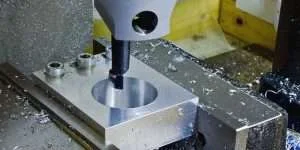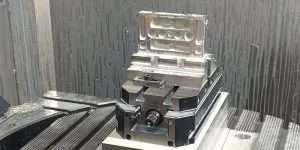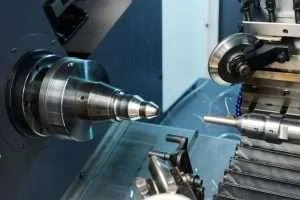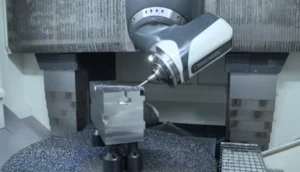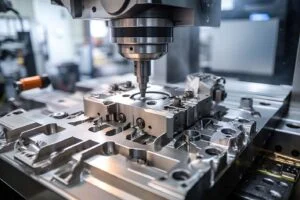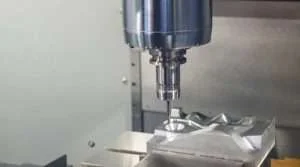Boring Machining is a subtractive manufacturing method used in various applications such as the automotive, manufacturing, and aerospace industries where precise and accurate hole machining is required.
In addition, with advanced boring machines, boring operations can reduce production duration, improve surface finishes, and allow for custom-sized holes, which is vital in aerospace and medical device applications that require high precision.
What is Boring Machining?
Boring Machining is a machining process that uses a specially designed cutting tool like a drill bit to enlarge a hole that is already in the part to improve accuracy. Therefore, the boring manufacturing process allows for the creation of precise holes that meet tight tolerances and specific design requirements.

When and Where is Boring Used?
Boring is a process used when specific enlargements of existing holes are required. For example, the automotive industry is widely employed in the production of engine blocks and cylinder heads. In chatter in machining, the cylinders to precise specifications, engine performance, and reliability can be enhanced. Also, in aircraft manufacturing, boring machining is used to create precise holes in turbine engine components, such as aircraft engine casings and landing gear components.
How to Bore a Hole?
Boring a hole is a standard machining operation that typically requires using a machine or a lathe. Choose the tool based on the size and depth of the hole you want to create. Ensure that the workpiece is securely held in place either in a lathe chuck or a vise, depending on the setup.
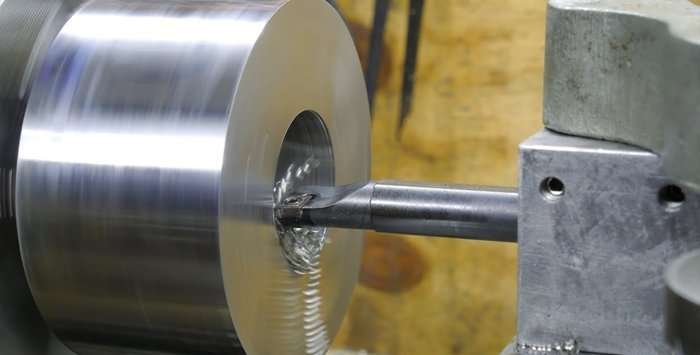
Mount the boring tool into the machine’s tool holder and move the tool into the starting position, lined up with the center of the existing hole or the desired location for the new hole. Then, switch on the machine and adjust the speed and feed rate settings based on the material you are working with and the hole size.
On the one hand, with a lathe machine, place the boring machining bar into the already existing hole. As the machine rotates the workpiece, the cutting insert cuts the edges of the hole, enlarging it in the process. On the other hand, when using a milling machine, the workpiece is clasped in a stationary position and the cutting tool rotates to widen the hole.
In both instances, the hole is enlarged until the desired surface finish and dimensions are achieved. Once you have bored out a hole, retract the tool and switch off the machine. Remove the workpiece and deburr the hole if necessary, to remove any sharp edges or burrs.
Types of Boring Machines
Boring machines, also known as boring lathes, are powerful tools for enlarging and shaping holes in materials like metal, wood, or stone. Here are a few types of boring machines.
Vertical Boring Machines
A vertical boring machine is designed to handle heavy and large workpieces that are difficult to maneuver on a traditional lathe. It has a vertical spindle, meaning the workpiece is placed on a rotating table. The cutting tool, such as a boring bar or drill, is guided vertically towards the workpiece to perform various operations like boring machining.
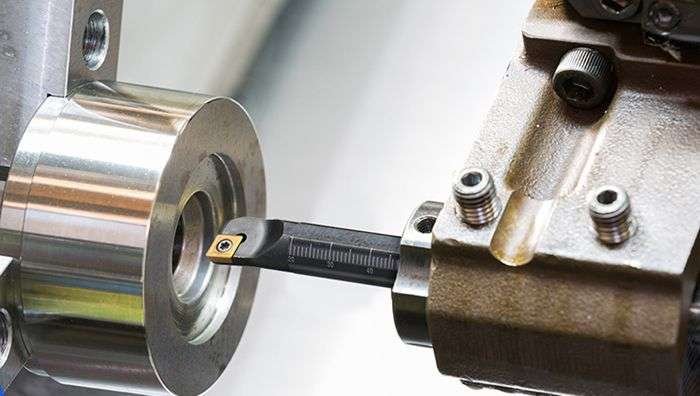
Horizontal Boring Machines
This type of boring machine is used to bore horizontally aligned holes. It typically consists of a spindle that can be adjusted to different angles to achieve the desired hole position. Unlike vertical boring machines with a vertical spindle orientation, horizontal boring machines have a horizontal spindle orientation. This orientation allows for more flexibility in terms of workpiece size and shape.
Precision Boring Machines
Precision boring machining are fantastic tools to enlarge existing holes or create precise cylindrical holes in various materials. These machines employ advanced technology to achieve high levels of accuracy and consistency. They often have features like digital readouts, adjustable spindle speeds, and precise feed rates.
In addition, using different cutting tools and techniques like CNC precision machining, these machines can create holes with tight tolerances, ensuring the perfect fit for various components.
Boring Tools Used in the Machining Process
Boring process utilizes a range of specialized tools. These tools are crucial in creating precision holes and smooth surfaces in various materials. Below are some of the tools used in boring a hole.

Boring Bars
A boring bar is a cutting tool primarily used to enlarge or create precision holes in workpieces. The primary purpose of a boring bar is to remove material from the inner diameter of a hole and achieve the desired size, shape, and surface finish.
It is carefully fed into the workpiece, rotating during boring machining manufacturing. The cutting head engages with the material and gradually removes material from the inner diameter of the hole. This process continues until the desired dimensions and surface finish are achieved.
Lathes or Milling Machine
A lathe is a machine tool used to rotate a workpiece so that various operations like boring, drilling, and thread CNC prototype machining can be performed on it. During the boring process, a lathe can be used to create cylindrical holes in a workpiece. The workpiece is clamped onto the spindle, which rotates at a controlled speed.
The cutting tool called a boring machining bar, is then fed into the workpiece to remove material and create the desired hole diameter. Lathes cutting tools are known for their accuracy and precision when it comes to boring operations.
Cutting Insert
A cutting insert is typically a small, often triangular or square-shaped, piece made of hard materials such as carbide, ceramic, or cubic boron nitride (CBN). During the boring process, the cutting insert is mounted onto a boring bar or tool holder, which is then inserted into the workpiece to create a cylindrical hole.
As the boring bar rotates, the insert’s cutting edges scrape away material, gradually enlarging the hole. The depth of cut and feed rate can be adjusted to achieve the desired dimensions and surface finish.
Challenges in Boring Machining Operations
Boring machining is one of the most commonly utilized operations in manufacturing industries. However, like most machining processes, several boring challenges require careful consideration and problem-solving.
Wear or Damage of Machine Part
CNC Boring involves continuous contact between the cutting tool and the workpiece, leading to tool wear and damage over time. During CNC aluminum machining, some workpiece materials react with the cutting tool’s coatings or compositions, resulting in chemical wear.
For instance, when machining materials with high carbon content, such as cast iron, the carbon can diffuse into the tool, making it brittle and prone to chipping or cracking.

Error in Machining
Any error or deviation from the desired specifications in hole machining can have negative effects on the boring machining process and the quality of the final product. Incorrect cutting parameters, such as feed rate, cutting speed, and depth of cut, can result in machining errors.
For example, using an incorrect feed rate can cause issues such as chatter marks and vibrations, leading to poor surface finish. Also, an inadequate feed rate may result in a material build-up on the cutting tool, while an excessive feed rate causes tool breakage or failure.
Surface Finish
Different materials have distinct challenges when it comes to achieving a good surface finish in bore machining. Harder materials like hardened steel or cast iron tend to be more challenging, as they can cause rapid tool wear and produce a rough surface finish.
Generally, the feed rate plays an essential role in achieving the desired surface finish of the bore parts. Machinists usually start boring at a feed rate of 0.1 to 0.2 mm per revolution. Excessively high feed rates can cause chatter, leading to surface imperfections.
Considerations and Tips for Optimal Boring Machining
The quality of the finished product will be improved by understanding the different parameters required when boring a hole. To achieve optimal results, here are some considerations and tips:

Tool Selection
Choosing the appropriate boring machining tool is crucial for achieving your desired results. Using high-quality tools such as solid carbide, indexable carbide, or coated high-speed steel will improve machining accuracy and reduce vibrations. Selecting the wrong tool can result in poor performance, increased wear, and reduced productivity during boring operations.
Cutting Parameters
Optimize the cutting parameters for your specific material and tooling combination. This includes selecting the appropriate cutting speed, feed rate, and depth of cut. This process helps to minimize error occurrence and increase efficiency.
Tool Setup and Alignment
Proper setup is essential for a successful boring operation. Make sure the workpiece is securely clamped and aligned accurately to avoid any deflection or movement during machining. Additionally, check that the cutting parameters, such as feed rate and spindle speed, are appropriate for the material being bored.
Coolant and Lubrication
Boring operations generate heat and cause friction, which can damage the tool, and workpiece, and negatively impact the surface finish. Ensure the usage of coolants or lubricants like soluble oils or synthetic fluids to regulate the temperature of the cutting tools and improve chip evacuation.
Other Making a Hole Methods in Manufacturing
In machining, there are multiple methods for making holes. Understanding the similarities and differences shared with boring machining helps to improve machining operations. Some of the ways include:

Boring vs Drilling
Drilling refers to creating a hole in a workpiece using a drill bit. It is primarily used to create simple, straight holes of various diameters. The drill bit rotates and exerts axial force to remove material and make the hole. Drilling boring machining are commonly used in construction, metalworking, woodworking, and many other industries.
In boring vs drilling, it is important to note that before boring, you need to drill a hole. Both processes require precision and accuracy to achieve the desired results. Whether it’s enlarging an existing hole or creating a new one, both boring and drilling machining demand careful control to meet the required specifications.
One significant difference is the level of precision and accuracy. Boring machining offers a higher accuracy of about 0.0005 inches and is often used in applications that require tight tolerances. On the other hand, drilling has an accuracy level of up to 0.02 inches.
Boring vs Reaming
Reaming is a process that involves using a cutting tool called a reamer to remove material from the inside of a hole, making it smoother, straighter, and more precise. The reamer has multiple cutting edges with a slight taper, allowing it to remove a small amount of material accurately while producing a hole with tight tolerances.
The major distinction between reaming and boring is in its application. Reaming is commonly used when a high level of precision is required. Boring, on the other hand, is frequently employed in applications where larger diameters are needed, including cylinder bores, engine blocks, and machining large diameters.
Get Boring Machining Services at XinCheng
At XinCheng, we understand the importance of accuracy and consistency in hole machining. Our advanced CNC machines are capable of handling a wide range of materials, providing cost-effective solutions for your boring machining projects. From prototyping to production, our CNC milling and CNC turning services are always ready to meet your unique requirements.
Conclusión
Boring machining is vital in industries where precise and accurate hole creation or enlargement is required. It helps ensure various mechanical systems and structures’ functionality, reliability, and performance. By utilizing advanced machining techniques, engineers can achieve the specifications and tolerances necessary for optimal operation.
Preguntas frecuentes
What common types of materials can be machined using boring operations?
Common materials include aluminum, steel, plastic, and wood.
What are the advantages of boring manufacturing?
The advantages include higher accuracy, clean surface finishes, and the ability to make customizable holes.
What are the optimal parameters that ensure a smooth boring process?
The major optimal parameters that provide a successful boring process are speed, feed, and depth of cut.

